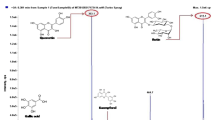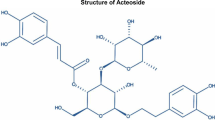Abstract
Epilepsy is a serious public health problem in the world. At present, over 30% of affected patients remain refractory to currently available treatment. Medicinal plants as pharmaceuticals and healthcare treatments have been frequently used in the management of epilepsy in China for many centuries. Gastrodia elata-Acous tatarinowii (GEAT), as a classic and most commonly used herb pair in traditional Chinese medicine (TCM), has been employed to control seizures for thousands of years. However, the animal experiment data on its anticonvulsant effect is limited in the literature. Thus, this study aimed to reveal the therapeutic actions of GEAT decoction against seizures in mice. UHPLC-MS/MS was performed to analyze the chemical components of GEAT decoction. The mice were given GEAT decoction for 7 days, and MES, PTZ, and 3-MP injection was given 30 min after the last administration. Video monitoring was performed for comparisons. In addition, the PTZ-induced kindling models were conducted to investigate the seizure severity, anxiety and cognitive profile, inflammation, and oxidative stress parameters in mice. The results showed that GEAT decoction dose-dependently protected mice against MES, 3-MP, and PTZ-induced acute seizures. Furthermore, GEAT decoction significantly ameliorated seizure severity, decreased the accumulation of inflammatory mediators TNF-α, IL-1β, and IL-6, mitigated oxidative stress, as well as alleviated anxious-like behavior and cognitive deficits in PTZ-kindled mice. These results suggest that GEAT decoction possesses certain anticonvulsant properties, which might be clinically useful as phytotherapy alone or as an adjunct therapy for the prevention and treatment of seizures and epilepsy.






Similar content being viewed by others
Data Availability
Data will be provided upon a reasonable request.
References
Bai Y, He X, Bai Y, Sun Y, Zhao Z, Chen X et al (2019) Polygala tenuifolia-Acori tatarinowii herbal pair as an inspiration for substituted cinnamic α-asaronol esters: Design, synthesis, anticonvulsant activity, and inhibition of lactate dehydrogenase study. Eur J Med Chem 183:111650. https://doi.org/10.1016/j.ejmech.2019.111650
Bao CX, Huang W, Wang XF (2012) Modern literature analysis of traditional Chinese medicine in the treatment of childhood epilepsy. Chin Pediatr Integr Tradit Western Med 6:492–493
Bauer J, Becker AJ, Elyaman W, Peltola J, Rüegg S, Titulaer MJ (2017) Innate and adaptive immunity in human epilepsies. Epilepsia 58(Suppl 3):57–68. https://doi.org/10.1111/epi.13784
Beghi E (2020) The Epidemiology of Epilepsy. Neuroepidemiology 54(2):185–191. https://doi.org/10.1159/000503831
China Association Against Epilepsy (2015) Clinical diagnosis and treatment guidelines: epilepsy (2015 revision). People's Medical Publishing House, Beijing, p 11
Chindo BA, Howes MR, Abuhamdah S, Yakubu MI, Ayuba GI, Battison A et al (2021) New insights into the anticonvulsant effects of essential oil from Melissa officinalis L. (Lemon Balm). Front Pharmacol 12:760674. https://doi.org/10.3389/fphar.2021.760674
Chinese Pharmacopoeia Committee (2020) Pharmacopoeia of the People’s Republic of China. China Medical Science and Technology Press, Beijing
de Lima Rosa G, Muller Guzzo E, MuliternoDomingues A, BremmPadilha R, de Oliveira Dias, Amaral V, Simon Coitinho A (2021) Effects of prednisolone on behavioral and inflammatory profile in animal model of PTZ-induced seizure. Neurosci Lett 743:135560. https://doi.org/10.1016/j.neulet.2020.135560
Ding D, Zhou D, Sander JW, Wang W, Li S, Hong Z (2021) Epilepsy in China: major progress in the past two decades. Lancet Neurol 20(4):316–326. https://doi.org/10.1016/S1474-4422(21)00023-5
Elgarhi R, Shehata MM, Abdelsameea AA, Salem AE (2020) Effects of diclofenac versus meloxicam in pentylenetetrazol-kindled mice. Neurochem Res 45(8):1913–1919. https://doi.org/10.1007/s11064-020-03054-7
Flores-Fuentes N, Hernandez-Cruz C, Bermeo K, Barajas-Martinez A, Hernandez-Serratos VN, Aceves-Rodriguez EM et al (2021) Motor learning impairment in rats under a high sucrose diet. Physiol Behav 234:113384. https://doi.org/10.1016/j.physbeh.2021.113384
Frantz AL, Regner GG, Pflüger P, Coelho VR, da Silva LL, Viau CM et al (2017) Manual acupuncture improves parameters associated with oxidative stress and inflammation in PTZ-induced kindling in mice. Neurosci Lett 661:33–40. https://doi.org/10.1016/j.neulet.2017.09.044
Goerl B, Watkins S, Metcalf C, Smith M, Beenhakker M (2021) Cannabidiolic acid exhibits entourage-like improvements of anticonvulsant activity in an acute rat model of seizures. Epilepsy Res 169:106525. https://doi.org/10.1016/j.eplepsyres.2020.106525
Golyala A, Kwan P (2017) Drug development for refractory epilepsy: The past 25 years and beyond. Seizure 44:147–156. https://doi.org/10.1016/j.seizure.2016.11.022
Guillén-Ruiz G, Cueto-Escobedo J, Hernández-López F, Rivera-Aburto LE, Herrera-Huerta EV, Rodríguez-Landa JF (2021) Estrous cycle modulates the anxiogenic effects of caffeine in the elevated plus maze and light/dark box in female rats. Behav Brain Res 413:113469. https://doi.org/10.1016/j.bbr.2021.113469
He XR, Bai YJ, Zeng M, Zhao ZF, Zhang Q, Xu N et al (2018) Anticonvulsant activities of α-asaronol ((E)-3’-hydroxyasarone), an active constituent derived from α-asarone. Pharmacol Rep 70(1):69–74. https://doi.org/10.1016/j.pharep.2017.08.004
He XR, Yang Y, Yuan XF, Sun Y, Li YS. Evaluation of the Anticonvulsant Activities of Gastrodia Elata Bl.-Acorus Tatarinowii Decoction on Experimentally Induced Seizures in Mice. 2022. https://doi.org/10.21203/rs.3.rs-1216659/v2.
Hundallah K, Tabarki B (2021) Treatable inherited metabolic epilepsies. Neurosciences (Riyadh) 26(3):229–235. https://doi.org/10.17712/nsj.2021.3.20210077
Hwang ST, Stevens SJ, Fu AX, Proteasa SV (2019) Intractable generalized epilepsy: Therapeutic approaches. Curr Neurol Neurosci Rep 19(4):16. https://doi.org/10.1007/s11910-019-0933-z
Jin M, Zhang B, Sun Y, Zhang S, Li X, Sik A et al (2020) Involvement of peroxisome proliferator-activated receptor γ in anticonvulsant activity of α-asaronol against pentylenetetrazole-induced seizures in zebrafish. Neuropharmacology 162:107760. https://doi.org/10.1016/j.neuropharm.2019.107760
Kaur H, Patro I, Tikoo K, Sandhir R (2015) Curcumin attenuates inflammatory response and cognitive deficits in experimental model of chronic epilepsy. Neurochem Int 40–50. https://doi.org/10.1016/j.neuint.2015.07.009
Khattak ZF, Ansari B, Jamal M, Awan AA, Sherkheli MA, UlHaq R (2021) Anticonvulsant activity of methanolic extract of Withania cogulans in mice. Metab Brain Dis 36(8):2437–2443. https://doi.org/10.1007/s11011-021-00850-0
Kondrat-Wróbel MW, Łuszczki JJ (2018) Isobolographic additivity among lacosamide, lamotrigine and phenobarbital in a mouse tonic-clonic seizure model. Adv Clin Exp Med 27(7):881–886
Krall RL, Penry JK, White BG, Kupferberg HJ, Swinyard EA (1978) Antiepileptic drug development: II. Anticonvulsant drug screening Epilepsia. Raven Press New York 19:409–428
Knight P, Chellian R, Wilson R, Behnood-Rod A, Panunzio S, Bruijnzeel AW (2021) Sex differences in the elevated plus-maze test and large open field test in adult Wistar rats. Pharmacol Biochem Behav 204:173168. https://doi.org/10.1016/j.pbb.2021.173168
Li J, Sun M, Wang X (2020) The adverse-effect profile of lacosamide. Expert Opin Drug Saf 19(2):131–138. https://doi.org/10.1080/14740338.2020.1713089
Lin CH, Hsieh CL (2021) Chinese herbal medicine for treating epilepsy. Front Neurosci 15:682821. https://doi.org/10.3389/fnins.2021.682821
Löscher W, Klein P (2020) The feast and famine: Epilepsy treatment and treatment gaps in early 21st century. Neuropharmacology 170:108055. https://doi.org/10.1016/j.neuropharm.2020.108055
Mitelpunkt A, Kramer U, HausmanKedem M, Zilbershot Fink E, Orbach R, Chernuha V et al (2019) The safety, tolerability, and effectiveness of PTL-101, an oral cannabidiol formulation, in pediatric intractable epilepsy: A phase II, open-label, single-center study. Epilepsy Behav 98(Pt A):233–237. https://doi.org/10.1016/j.yebeh.2019.07.007
Pérez-Pérez D, Castañeda-Cabral JL, Orozco-Suárez S, Sotelo J, Besio W, Rocha L (2021) Noninvasive transcranial focal stimulation affects the convulsive seizure-induced P-glycoprotein expression and function in rats. Epilepsy Behav 115:107659
Sharma AA, Goodman AM, Allendorfer JB, Philip NS, Correia S, LaFrance WC Jr et al (2021) Regional brain atrophy and aberrant cortical folding relate to anxiety and depression in patients with traumatic brain injury and psychogenic nonepileptic seizures. Epilepsia. https://doi.org/10.1111/epi.17109
Shuman T, Aharoni D, Cai DJ, Lee CR, Chavlis S, Page-Harley L et al (2020) Breakdown of spatial coding and interneuron synchronization in epileptic mice. Nat Neurosci 23(2):229–238. https://doi.org/10.1038/s41593-019-0559-0.E
Silva B, Canas-Simião H, Cordeiro S, Velosa A, Oliveira-Maia AJ, Barahona-Corrêa JB (2019) Determinants of quality of life in patients with drug-resistant focal epilepsy. Epilepsy Behav 100(Pt A):106525. https://doi.org/10.1016/j.yebeh.2019.106525
Thijs RD, Surges R, O’Brien TJ, Sander JW (2019) Epilepsy in adults. Lancet 393(10172):689–701. https://doi.org/10.1016/S0140-6736(18)32596-0
Uthara SS, Basheer M, Anil BA (2017) A review on cost effective analysis of antiepileptic drugs. Int J Bioassays 6(9):5507. https://doi.org/10.21746/ijbio.2017.9.6
Xiao F, Yan B, Chen L, Zhou D (2015) Review of the use of botanicals for epilepsy in complementary medical systems–traditional Chinese medicine. Epilepsy Behav 52(Pt B):281–289. https://doi.org/10.1016/j.yebeh.2015.04.050
Zhao Z, He X, Ma C, Wu S, Cuan Y, Sun Y et al (2018) Excavating Anticonvulsant Compounds from Prescriptions of Traditional Chinese Medicine in the Treatment of Epilepsy. Am J Chin Med 46(4):707–737. https://doi.org/10.1142/S0192415X18500374
Zhang L, Sun W, Xu L, Wang Y, Zhu G, Wu X et al (2019) The anticonvulsant and neuroprotective effects of kir2.3 activation in PTZ-induced seizures and the kainic acid model of TLE. Epilepsy Res 156:106167. https://doi.org/10.1016/j.eplepsyres.2019.106167
Funding
This work was supported by the National Natural Science Foundation of China [No. 82260865], the Science and technology projects of Guizhou Province (Qian Kehe foundation-ZK [2021] General-550; Qian Kehe Platform Talents [2018]5772–074; Qian Kehe Platform Talents [2019]-017), and the Science and Technology Project of Zunyi (Grant No. ZSKH-HZ-(2020)-78).
Author information
Authors and Affiliations
Contributions
The manuscript was completed through the contributions of all the listed authors. H-XR, Y-Y, Y-XF, and S-Y designed and performed the experiments, and Y-Y and S-Y analyzed the data. H-XR wrote and helped to modify the paper. All authors read and approved the final version of the manuscript.
Corresponding authors
Ethics declarations
Ethics approval
Animal studies were performed in strict accordance with the guidelines for the Care and Use of Laboratory Animals and granted by the Ethics Committee of Zunyi Medical University (Date: July 30, 2020/NO: ZYLS-[2020] No. 2–081).
Consent to participate
Not applicable.
Consent for publication
Not applicable.
Competing Interests
The authors declare that there is no conflict of interest.
Others
A preprint has previously been published [He et al. 2022] in “research square”, it has not been published by a journal.
Additional information
Publisher's note
Springer Nature remains neutral with regard to jurisdictional claims in published maps and institutional affiliations.
Rights and permissions
Springer Nature or its licensor (e.g. a society or other partner) holds exclusive rights to this article under a publishing agreement with the author(s) or other rightsholder(s); author self-archiving of the accepted manuscript version of this article is solely governed by the terms of such publishing agreement and applicable law.
About this article
Cite this article
He, X., Yang, Y., Yuan, X. et al. Chemical composition and anticonvulsant activities of herb pair of Gastrodia elata Blume-Acorus tatarinowii Schott decoction on experimentally induced seizures in mice. Metab Brain Dis 38, 1877–1893 (2023). https://doi.org/10.1007/s11011-023-01211-9
Received:
Accepted:
Published:
Issue Date:
DOI: https://doi.org/10.1007/s11011-023-01211-9




